NEWFOUNDLAND AND LABRADOR
REGULATION 57/19
Fault Determination Regulations
under the
Automobile Insurance Act
(O.C. 2019-214)
(Filed September 27, 2019)
Under the authority of section 60 of the Automobile Insurance Act, the Lieutenant-Governor in Council makes the following regulations.
Dated at St. John's, September 27, 2019.
Elizabeth Day
Clerk of the Executive Council
REGULATIONS
1.
Short title
4.
Determination of degree of fault
5.
Factors not included in determination of fault
6.
More than one provision of regulations apply
8.
Automobiles travelling in the same direction and lane
9.
Automobile entering road from parking place, private road or driveway
10.
Automobile entering controlled access highway
12.
Automobiles travelling in the same direction in adjacent lane
14.
Automobiles travelling in opposite directions
15.
Automobiles at intersection without traffic signals or signs
16.
Automobiles at intersection with traffic signs
17.
Automobiles at intersection with traffic signals
18.
Automobiles in parking lots
19.
Automobiles that are parked
20.
Driver fails to obey specified sign or direction
21.
Backing up, making U-turn or opening door
Short title
1. These regulations may be cited as the Fault Determination Regulations .
Interpretation
2. (1) In these regulations,
(a) "Act" means the Automobile Insurance Act ;
(b) "centre line" means one or more of the following:
(i) a single or double, solid or broken line marked in the middle of the roadway,
(ii) for a roadway without a line marked in the middle
(A) where the roadway is unobstructed, the middle of the roadway measured from the curbs or in the absence of curbs, from the edges of the roadway, or
(B)
where a portion of the roadway is obstructed by parked automobiles, snowbanks or other objects blocking traffic along the edge or edges of the roadway and two-way traffic past the obstruction is possible without difficulty, the middle of the unobstructed portion of the roadway, or
(iii) for a roadway with more lanes available for traffic in one direction than the other direction, the line dividing the lanes for traffic in different directions;
(c) "chain reaction" means a series of successive impacts among 3 or more automobiles travelling in the same direction one behind the other in the same lane;
(d) "collision" means
(i) impact between 2 or more automobiles or parts of automobiles being detached without the involvement of the insured, or
(ii) impact between an automobile and the load of another automobile;
(e) "controlled access highway" means controlled access highway as defined in the Highway Traffic Act ;
(f) "damage" includes one or more of the following:
(i) damage caused to an insured automobile,
(ii) loss of use of an insured automobile, and
(iii) loss or damage to property owned by an insured while being transported in an insured automobile;
(g) "feeder lane" means a road in a parking lot other than a thoroughfare;
(h) "highway" means highway as defined in the Highway Traffic Act ;
(i) "intersection" means the area enclosed within the lateral boundary lines of 2 or more roadways, or 2 or more lanes in a parking lot, that join one another at an angle, and lines drawn at right angles across each of the roadways, or lanes in the parking lot, from the points where the lateral boundary lines intersect;
(j) "pile-up" means an incident involving a series of impacts among 3 or more automobiles travelling in the same direction and in adjacent lanes;
(k) "private road or driveway" means a road or driveway not open to the use of the public for purposes of vehicular traffic;
(l) "roadway" means that portion of a highway ordinarily used for vehicular travel, exclusive of the shoulder unless the shoulder is paved;
(m) "thoroughfare" means a main road for passage into, through or out of a parking lot;
(n) "traffic control signal" means a manually, electrically or mechanically operated device by which traffic is alternately directed to stop and to proceed; and
(o) "traffic sign" includes all traffic control signals, warning sign-posts, signs, lines, marks or other devices for the guidance of persons using highways.
(2) References in these regulations to "automobile A", "automobile B" and "automobile C" are for ease of reference to the automobiles that may be involved in an incident and have no meaning other than as labels applied to distinguish between the automobiles.
(3) The diagrams in these regulations are merely illustrative of the situations described.
Application
3. (1) These regulations apply only for the purposes of determining fault under section 32.1 of the Act.
(2) These regulations apply to all automobiles.
(3) Notwithstanding subsection (2), these regulations do not apply to an automobile exempted from registration under the Highway Traffic Act , unless the automobile is insured by a motor vehicle liability policy.
Determination of degree of fault
4. An insurer shall determine the degree of fault of an insured for loss or damage arising directly or indirectly from the use or operation of an automobile in accordance with these regulations.
Factors not included in determination of fault
5. The degree to which an insured is at fault in an incident shall be determined without reference to
(a) the circumstances in which the incident occurs, including weather conditions, visibility or the actions of pedestrians; or
(b) where the point of contact between the insured's automobile and any other automobile involved in the incident is located on the insured's automobile.
More than one provision of regulations apply
6. (1) Where more than one provision of these regulations applies to an insured, the provision that attributes the least degree of fault to the insured is the provision that applies.
(2) Notwithstanding subsection (1), where 2 provisions of these regulations apply to an incident involving 2 automobiles and an insured would be 100% at fault under one provision and not at fault under the other provision, the insured is 50% at fault for the incident.
Ordinary rules of law
7. (1) Where an incident is not described in these regulations, the degree to which an insured is at fault shall be determined in accordance with the ordinary rules of law.
(2) Where there is insufficient information regarding an incident to determine the degree to which an insured is at fault, the degree of fault shall be determined in accordance with the ordinary rules of law unless these regulations require otherwise.
Automobiles travelling in the same direction and lane
8. (1) This section applies to an incident in which automobile A is struck from the rear by automobile B and both automobiles are travelling in the same direction and in the same lane.
(2) Where automobile A is stopped or is in forward motion when the incident occurs
(a) the driver of automobile A is not at fault for the incident; and
(b) the driver of automobile B is 100% at fault for the incident.
Diagram 8.2

(3) Where the incident occurs when automobile A is turning, either to the right or to the left, in order to enter a side road, private road or driveway
(a) the driver of automobile A is not at fault for the incident; and
(b) the driver of automobile B is 100% at fault for the incident.
Diagram 8.3

(4) Where the incident occurs when automobile A is in forward motion and is entering a parking place on either the right or the left side of the road
(a) the driver of automobile A is not at fault for the incident; and
(b) the driver of automobile B is 100% at fault for the incident.
Diagram 8.4

Automobile entering road from parking place, private road or driveway
9. (1) This section applies when automobile A collides with automobile B while automobile B is entering a road from a parking place, private road or driveway.
(2) Where the incident occurs when automobile B is leaving the parking place and automobile A is passing the parking place
(a) the driver of automobile A is not at fault for the incident; and
(b) the driver of automobile B is 100% at fault for the incident.
Diagram 9.2
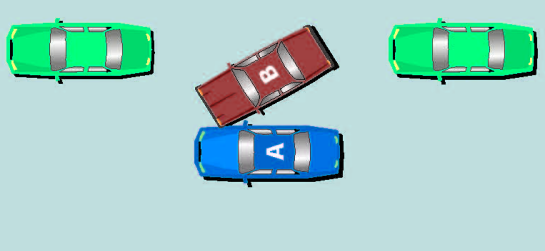
(3) Where the incident occurs when automobile B is entering a road from a private road or a driveway and automobile A is passing the private road or driveway, and there are no traffic signs
(a) the driver of automobile A is not at fault for the incident; and
(b) the driver of automobile B is 100% at fault for the incident.
Diagram 9.3
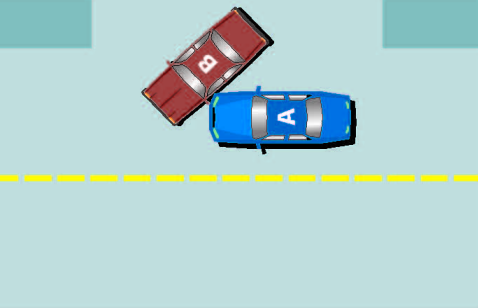
Automobile entering controlled access highway
10. Where automobile A collides with automobile B on a controlled access highway while automobile B is entering the highway from an entrance lane
(a) the driver of automobile A is not at fault for the incident; and
(b) the driver of automobile B is 100% at fault for the incident.
Diagram 10.1
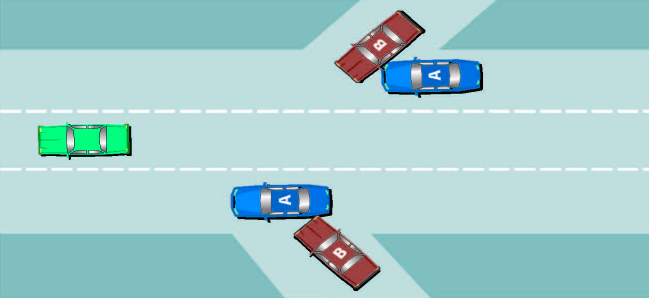
Chain reactions
11. (1) This section applies to chain reactions.
(2) The degree of fault for each collision between 2 automobiles involved in a chain reaction is determined without reference to any related collisions involving either of the automobiles and another automobile.
(3) Where all automobiles involved in a chain reaction are in motion and automobile A is the leading automobile, automobile B is the second automobile and automobile C is the third automobile
(a) in the collision between automobiles A and B
(i) the driver of automobile A is not at fault for the incident, and
(ii) the driver of automobile B is 50% at fault for the incident; and
(b) in the collision between automobiles B and C,
(i) the driver of automobiles B is not at fault for the incident; and
(ii) the driver of automobile C is 100% at fault for the incident.
Diagram 11.3
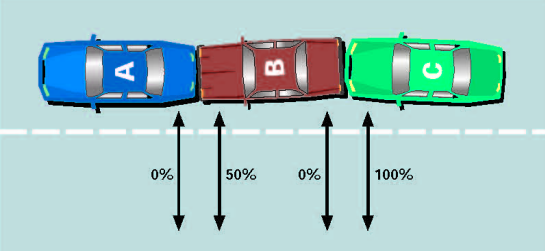
(4) Where only automobile C in a chain reaction is in motion when the incident occurs
(a) in the collision between automobiles A and B, neither driver is at fault for the incident; and
(b) in the collision between automobiles B and C,
(i) the driver of automobile B is not at fault for the incident, and
(ii) the driver of automobile C is 100% at fault for the incident.
Diagram 11.4
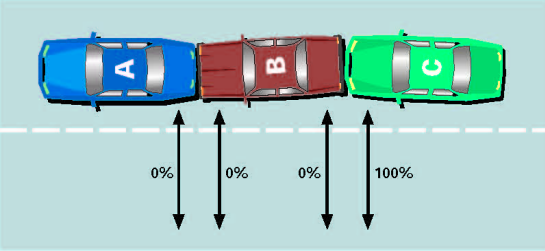
Automobiles travelling in the same direction in adjacent lane
12. (1) This section applies to an incident in which automobile A collides with automobile B and both automobiles are travelling in the same direction and in adjacent lanes.
(2) Where neither automobile A nor automobile B changes lanes, and both automobiles are on or over the centre line when the incident occurs, the driver of each automobile is 50% at fault for the incident.
Diagram 12.2
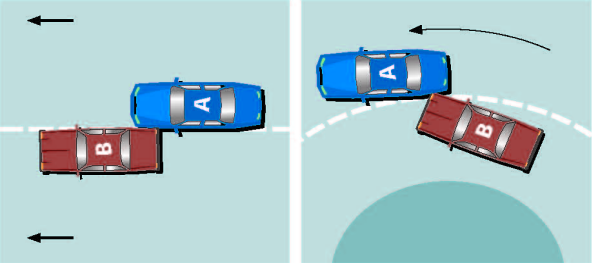
(3) Where the location on the road of automobiles A and B when the incident occurs cannot be determined, the driver of each automobile is 50% at fault for the incident.
Diagram 12.3
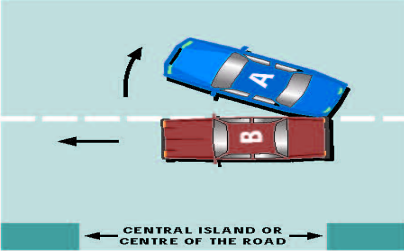
(4) Where the incident occurs when automobile B is changing lanes
(a) the driver of automobile A is not at fault for the incident; and
(b) the driver or automobile B is 100% at fault for the incident.
Diagram 12.4

(5) Where the incident occurs when automobile A is turning left at an intersection and automobile B is overtaking automobile A to pass it
(a) the driver of automobile A is not at fault for the incident; and
(b) the driver of automobile B is 100% at fault for the incident.
Diagram 12.5
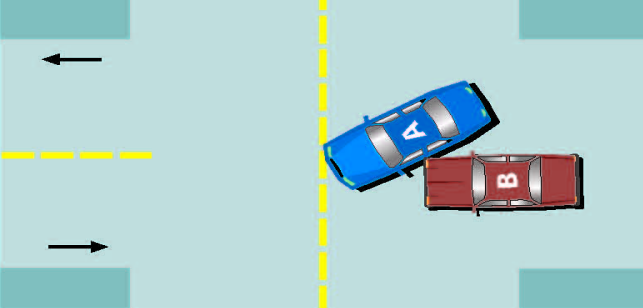
(6) Where the incident occurs when automobile A is turning left at a private road or a driveway and automobile B is overtaking automobile A to pass it
(a) the driver of automobile A is 75% at fault for the incident; and
(b) the driver of automobile B is 25% at fault for the incident.
Diagram 12.6
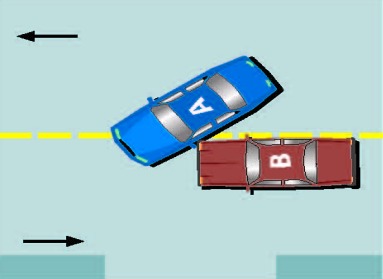

(7) Where the incident occurs when automobile A is turning left at a private road or a driveway and automobile B is passing one or more automobiles stopped behind automobile A
(a) the driver of automobile A is not at fault for the incident; and
(b) the driver of automobile B is 100% at fault for the incident.
Diagram 12.7
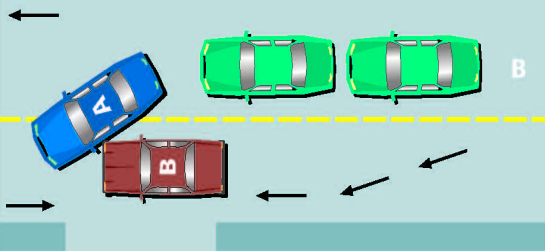
Pile-ups
13. (1) This section applies to pile-ups.
(2) For each collision between 2 automobiles involved in a pile-up, the driver of each automobile is 50% at fault for the incident.
Diagram 13.2

Automobiles travelling in opposite directions
14. (1) This section applies to an incident in which automobile A collides with automobile B and the automobiles are travelling in opposite directions and in adjacent lanes.
(2) Where neither automobile A nor automobile B changes lanes and both automobiles are on or over the centre line when the incident occurs, the driver of each automobile is 50% at fault for the incident.
Diagram 14.2
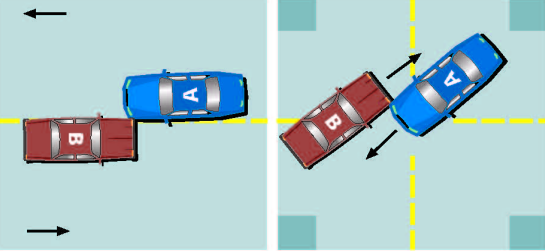
(3) Where the location on the road of automobiles A and B when the incident occurs cannot be determined, the driver of each automobile is 50% at fault for the incident.
Diagram 14.3
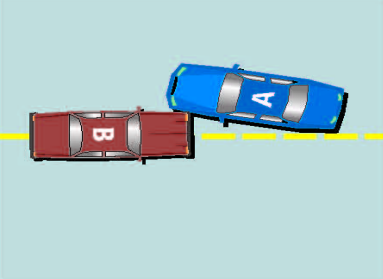
(4) Where only automobile B is over the centre line of the road when the incident occurs
(a) the driver of automobile A is not at fault for the incident; and
(b) the driver of automobile B is 100% at fault for the incident.
Diagram 14.4
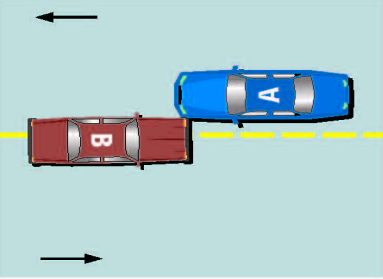
(5) Where the incident occurs when automobile B turns left into the path of automobile A
(a) the driver of automobile A is not at fault for the incident; and
(b) the driver of automobile B is 100% at fault for the incident.
Diagram 14.5
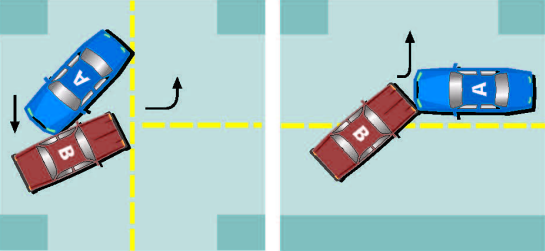
(6) Where automobile B is leaving a parking place or entering the road from a private road or driveway and automobile A is overtaking to pass another automobile when the incident occurs
(a) the driver of automobile A is not at fault for the incident; and
(b) the driver of automobile B is 100% at fault for the incident.
Diagram 14.6
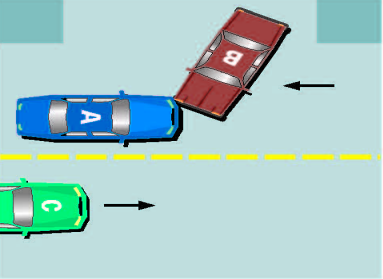
Automobiles at intersection without traffic signs
15. (1) This section applies to an incident in which automobile A collides with automobile B at an intersection that does not have traffic signs.
(2) Where automobile A enters the intersection before automobile B
(a) the driver of automobile A is not at fault for the incident; and
(b) the driver of automobile B is 100% at fault for the incident.
(3) Where automobiles A and B enter the intersection at the same time and automobile A is on the right of automobile B in the intersection
(a) the driver of automobile A is not at fault for the incident; and
(b) the driver of automobile B is 100% at fault for the incident.
(4) Where it cannot be determined whether automobile A or B entered the intersection first, the driver or each automobile is 50% at fault for the incident.
Automobiles at intersection with traffic signs
16. (1) This section applies to an incident in which automobile A collides with automobile B at an intersection with traffic signs.
(2) Where the incident occurs when the driver of automobile B fails to obey a stop sign, yield sign or a similar sign or flares or other signals on the ground
(a) the driver of automobile A is not at fault for the incident; and
(b) the driver of automobile B is 100% at fault for the incident.
(3) Where the driver of each automobile fails to obey a stop sign, the driver of each automobile is 50% at fault for the incident.
(4) Where it cannot be determined who failed to obey a stop sign, the driver of each automobile is 50% at fault for the incident.
(5) Where automobile A arrives at an all-way stop intersection first and stops
(a) the driver of automobile A is not at fault for the incident; and
(b) the driver of automobile B is 100% at fault for the incident.
(6) Where both automobiles arrive at an all-way stop intersection at the same time and stop, with automobile A to the right of automobile B
(a) the driver of automobile A is not at fault for the incident; and
(b) the driver of automobile B is 100% at fault for the incident.
(7) Where it cannot be determined who arrived at an all-way stop intersection first, the driver of each automobile is 50% at fault for the incident.
Automobiles at intersection with traffic signals
17. (1) This section applies to an incident in which automobile A collides with automobile B at an intersection with traffic control signals.
(2) Where the driver of automobile B fails to obey a traffic control signal
(a) the driver of automobile A is not at fault for the incident; and
(b) the driver of automobile B is 100% at fault for the incident.
(3) Where it cannot be determined whether the driver of either automobile failed to obey a traffic control signal, the driver of each automobile is 50% at fault for the incident.
(4) Where the traffic control signals at an intersection are inoperative, the degree to which each of the drivers is at fault is determined in accordance with these regulations as if the intersection were an all-way stop intersection.
Automobiles in parking lots
18. (1) This section applies to an incident in which automobile A collides with automobile B in a parking lot.
(2) The degree to which a driver is at fault in an incident that occurs on a thoroughfare is determined in accordance with these regulations as if the thoroughfare were a roadway.
(3) Where the incident occurs when automobile A is leaving a feeder lane and fails to yield the right of way to automobile B on a thoroughfare
(a) the driver of automobile A is 100% at fault for the incident; and
(b) the driver of automobile B is not at fault for the incident.
(4) Where the incident occurs when automobile A is leaving a parking space and fails to yield the right of way to automobile B on a feeder lane or a thoroughfare
(a) the driver of automobile A is 100% at fault for the incident; and
(b) the driver of automobile B is not at fault for the incident.
Automobiles that are parked
19. (1) Where automobile A is parked when automobile B collides with it
(a) the driver of automobile A is not at fault for the incident; and
(b) the driver of automobile B is 100% at fault for the incident.
(2) Notwithstanding subsection (1), where automobile A is illegally parked, stopped or standing when automobile B collides with it and the incident occurs outside a city, town or rural community
(a) the driver of automobile A is 100% at fault for the incident; and
(b) the driver of automobile B is not at fault for the incident.
Driver fails to obey specified sign or direction
20. The driver of automobile A is 100% at fault and the driver of automobile B is not at fault for an incident in which automobile A collides with automobile B when the driver of automobile A fails to obey one or more of the following:
(a) a peace officer's direction;
(b) a do not enter sign;
(c) a prohibited passing sign; or
(d) a prohibited turn sign.
Backing up, making U-turn or opening door
21. The driver of automobile A is 100% at fault and the driver of automobile B is not at fault for an incident that occurs when
(a) automobile A is backing up;
(b) automobile A is making a U-turn; or
(c) the driver of or a passenger in automobile A opens the automobile door or leaves the door open.
Driver charged with a driving offence
22. (1) The degree to which an insured is at fault in an incident is determined in accordance with the ordinary rules of law and not in accordance with these regulations where
(a) the driver of automobile A involved in the incident is charged with a driving offence; and
(b) the driver of automobile B is wholly or partly at fault, as otherwise determined under these regulations, for the incident.
(2) For the purposes of these regulations, where one or more of the following occurs as a result of an incident it constitutes a driving offence:
(a) a driver is charged with operating an automobile while the driver's ability to operate the automobile was impaired by alcohol or a drug or by a combination of alcohol and a drug;
(b) a driver is charged with driving while the driver's blood level or blood drug concentration level exceeded the limits permitted by law;
(c) a driver is charged with an indictable offence related to the operation of an automobile;
(d) a driver is asked to provide a breath sample or a sample of a bodily substance and the driver is charged with failing or refusing to provide the sample;
(e) a driver is charged with exceeding the speed limit by 31 or more kilometres per hour; or
(f) a driver is given a demand to perform physical coordination tests or submit to an evaluation and the driver is charged with failing or refusing to comply with the demand.
Voluntary payment
23. For the purposes of paragraph 32.1(6)(c) of the Act, acceptance of a voluntary payment by the insurer of a person who is not at fault from a person who is at fault in the amount the insurer paid as indemnity in respect of its insured is not subrogation against the person who made the payment.
Commencement
24.
These regulations come into force on January 1, 2020.
©Queen's Printer